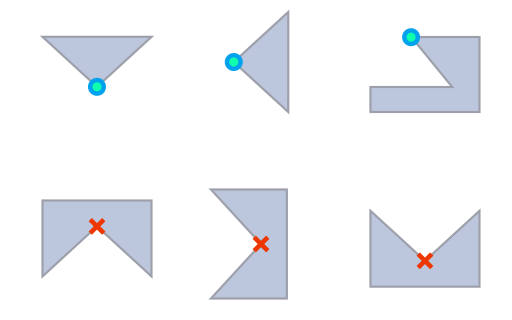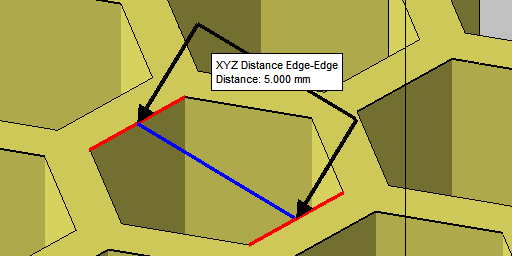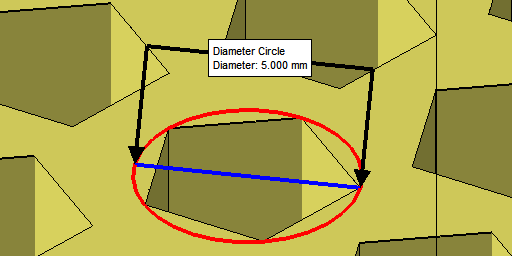Traces an edge with a row of bar supports. Use when the edge's side walls do not qualify as area clusters.
 Previously called
Edge with bar support
Previously called
Edge with bar support
Definition of "edge" in the context of this support action
- non-flat junction between two triangles
- convex on the outside (diverging normal vectors)
- angle between adjacent normals of 40° and more
- visible in orthogonal -Z projection, ignoring self-occlusion

Part sections seen from the side. The top row shows edges supportable with this action, the bottom row shows edges ignored by it. Not shown: Angle minimum of 40° between normals of triangles along a qualifying edge.
Jump to:
General parameters
| Parameter | Description | Notes |
|---|---|---|
| Description |
Holds a text label for the action that remains visible even when the action parameters are collapsed in the script tab |
|
 Color
Color
|
Sets a display color for the support elements generated by this action |
Cannot be reverted once changed, only explicitly set to a new color |
| Maximum edge angle to XY-plane |
Describes the maximum angle between an edge and the XY plane. If the maximum angle is exceeded, the edge is disregarded for applying supports. |
0-90° |
| Neighbor area angle |
Angle of triangles against the horizontal, along an edge, where (in Z) one of the triangles is below the edge. Edges where the lower triangle is angled against the horizontal shallower than this angle do receive edge support, too. |
0-90° |
| Anchor distance |
Sets the distance between two anchor points. |
1-100 mm |
| Contour offset |
Sets the distance between an anchor point and a clear area. |
0-5 mm |
| Startpoint distance |
Sets the border distance between the edge and the start of the support structure |
0-5 mm |
| Z-range limitation |
Even when an edge spans a greater height range than given by Minimum Z value and Maximum Z value, only those anchors sprout bars that lie within the values specified here. |
|
 Groups
Groups
|
Forms groups of bars for optional cross-bracing, bunching with a tapering envelope, and generating local baseplates |
See Groups |
 Brace
Brace
|
Generates cross-bracing bars between bars in a group |
See Brace |
| Support properties Bar |
Parametrization for the shape of the bars generated for this support actions |
|
 Support properties Baseplate
Support properties Baseplate
|
Parametrization for the shape of local baseplates generated for grouped bars |
See Support properties Baseplate |
 Groups
Groups
There is no explicit switch to turn grouping off. It is technically always active, but as long as no tapering, bracing, or generation of a local baseplate is specified, it has no effect.
| Parameter | Explanation | Notes |
|---|---|---|
| Bars per group |
Bunches at most this many bars into a group. A group of bars may receive braces, may have a local baseplate, and the group as a whole may be tapered. |
|
| Group taper |
Controls the taper of a group of bars
|
Unavailable while Bars per group is <2 or Number of legs is >0 |
| Baseplate for group |
Adds a local baseplate to a group's contact point or patch on the platform |
Unavailable while Number of legs is >0 |
 Pad height,
Contour offset,
Taper angle, or their equivalents, have been moved to the separate
Support properties Baseplate section.
Pad height,
Contour offset,
Taper angle, or their equivalents, have been moved to the separate
Support properties Baseplate section.
 Brace
Brace
| Parameter | Explanation | Notes |
|---|---|---|
| Brace |
Arrangement and orientation of the cross-bracing bars given by the capital letters resembling the shape |
|
| Links per bar |
A bar in a group may be linked to up to this many other bars by cross-bracing |
|
| Link angle |
Lowest angle against the horizontal for the cross-bracing bars |
|
| Junction shape |
Adapts or overrides the type of junction that the cross-bracing bars use to transition into the bars they connect between. For example, while the main bar may prescribe a straight connection in Support properties, any connecting bars generated out of bracing could still have straight connections. |
|
 Support properties Baseplate
Support properties Baseplate
These local baseplates generate for groups of bars when is set to Yes. These baseplates are distinct from .
| Parameter | Explanation | Notes |
|---|---|---|
| Outer offset |
Distance by which the minimum contour formed by the contact points of a group's bars is extended to make the base plate's contour. This is the minimum distance before tapering. For the Pattern of Point connection net, no offset is generated. Instead this value is used to derive the wall thickness of the point connections, using effectively twice this value. |
|
| Maximum height |
The base plate's thickness |
|
| Taper angle |
Applies a taper to the base plate's circumference. Positive angles taper the plate towards the top. Tapering only ever adds onto the contour offset. |
|
| Pattern |
A selection of structures applicable to the baseplate |
|
| Cell size |
Size of the holes for Rectangular and Hexagonal, measured at right angles between wall surfaces, or outer diameter for Circular and Column, respectively  
|
Rectangular, Hexagonal, Circular, Column only |
| Pattern wall thickness |
Thickness of walls between holes, or gap between columns |
|
| Perimeter wall thickness |
Generates a wall along the perimeter of this thickness |
|
| Polygon corner |
Affects triangle resolution of the circular features |
Circular, Column only |
| Minimum pattern area |
A filter to help suppress fragments. Holes are suppressed (filled) if area cannot meet minimum fraction |
|
| Minimum structure hatch |
A filter to suppress any polygon stretches shorter along the XY plane than the given value. |
|
